Everything you need to know about legal SUPPRESSORS
by Dick Jones Contributing Editor
Since my days as a youth watching TV crime dramas, I’ve been interested in silencers. Or course, even the name used is not exactly correct; there is really nothing that can truly silence a firearm’s report. A more accurate nomenclature is suppressor and the good ones are remarkably quiet, almost as quiet as the “silencers” used in those black and white TV shows.
Most of those TV depictions were ridiculous in the level of authenticity, since it’s impossible to silence a revolver and the silencers used were the size of a bicycle grip and reduced the sound of a two-inch revolver to an almost inaudible “thutt.” In spite of this, the idea of firing a shot with little noise is naturally intriguing to many of us who love to shoot. In the past couple of years, I’ve noticed more and more suppressors in the hands of individuals shooting both handguns and rifles.
While most legal definitions refer to them as silencers, as mentioned above, the word is a little misleading. Most industry sources refer to them as suppressors since they muffle the sound of the shot but don’t eliminate all sound.
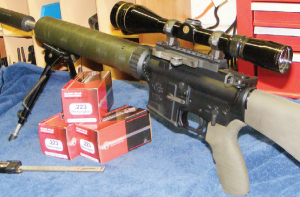
While a suppressor will change the zero slightly, it has no effect on accuracy. This Rock River match rifle will shoot ¾- inch groups using quality ammunition like Black Hills Match. Zero changed only about an inch but group size was unaffected when shooting with the suppressor.
In the case of subsonic ammunition, the sound is reduced considerably.
Often, subsonic suppressors are so effective you can hear the action of a semi-auto working and the sound of the brass plinking on concrete. Once the projectile exceeds the speed of sound, however, suppressors lose some of their advantage.
The suppressor still quiets the report of the shot being fired but the supersonic projectile creates a sonic crack that occurs as the bullet travels through the atmosphere.
Typically, a .223 or .308 sounds like an unsuppressed .22 long rifle round from a rifle.
To correctly understand how a suppressor works, you must understand a little bit about the nature of sound. What we perceive as sound is a pressure wave. To explain how that wave travels and how it’s measured would require more text than I can use here, and most readers would lose interest before they acquired understanding.
There is a scale for measuring sound levels that are potentially dangerous to hearing and that scale is the dBA scale we are all somewhat familiar with. It’s important to remember that it’s sometimes difficult to determine sound levels with our ears and that perceived levels of sound don’t always rank the same as they would on the dBA scale due to frequency and duration differences. dBA measures peak sound pressure but the length of the event is noticeable to our ears. For example, the dBA rating of the report of a .308 Winchester is the same as the report of a .300 Winchester Magnum but, since the .300’s report lasts longer, it seems louder to the human ear.
Since the report of a suppressed firearm varies widely due to the ammunition used, many manufacturers of suppressors don’t give a dBA reduction rating but rather state that the suppressor allows the firearm to operate within safe OSHA sound levels. For all but the most serious law enforcement and military applications, this is a sufficient noise reduction to meet the recreational shooter’s needs. A further advantage is that the suppressor not only changes the level of the noise, it also alters the nature of the sound, making the firing of a shot sound like something other than the firing of a shot.
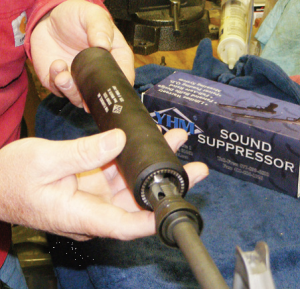
The quick detach mount on this Yankee Hill unit incorporates spring detents in the mount to assure it can be hand tightened and not back off.
Silencers or suppressors work on the same principle as a car muffler. The loud report we hear when a gun fires is caused by the escaping gasses traveling at supersonic speeds and creating a sonic crack. The baffles inside a suppressor create chambers to reduce the speed of escaping gasses. Since these gasses are traveling at high velocity and have mass, they contribute to recoil; the suppressor holds these gasses back and in doing so, recoil is reduced by as much as 15%. Additionally, the fact that these gasses change directions can cause energy to be directed in the opposite direction, further reducing recoil. Add this to the additional weight on the muzzle of the gun and muzzle flip can be noticeably reduced.
In addition to the noise generated by the muzzle report and sonic snap, firearms generate other noise. In the case of revolvers, gas leaking between the cylinder and barrel gap precludes the ability to adequately suppress noise. Other sounds generated come from the mechanism of the gun operating and, in the case of semi-autos; considerable noise can come as the bolt opens with some residual pressure still in the barrel. With the best quality suppressors, subsonic ammunition, and a closed bolt, suppressed guns aren’t silent, but surprisingly quiet.
While most suppressors are purchased as stand-alone units commonly known as “cans,” suppressors can come in the form of integral units made into the barrel of the firearm and sometimes almost indistinguishable from an unaltered gun. Popular guns for this arrangement are Ruger 10/22s and Mark III pistols since rimfire suppressors can be quite small. The extra size and weight of centerfire integral models makes them less popular.
Suppressors are so effective in reducing muzzle blast, they’re a boon to snipers since muzzle blast in dust can instantly reveal the sniper’s position.
While most sniper calibers are supersonic, the snap of the bullet is less likely to reveal the source of the shot than the report from the muzzle.
Another advantage of firing a suppressed firearm relates to anticipation of recoil or flinch. Flinch is caused by both recoil and noise, and the subdued noise of a suppressed gun can sometimes allow more consistent trigger control. The reduced noise and sup pressed recoil seem to smooth out the process of firing the shot and can sometimes benefit scores.
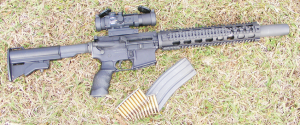
A .223 Short Barreled Rifle created and registered by Jim Weaver of Top Ends Inc. with a Yankee Hill quick detach can under the handguard. Guns like this work great for a tactical rifle and three-gun matches.
For those of us who live in more congested areas, the suppression of firearms noise can be a valuable tool to allow us to shoot as much as we like without disturbing neighbors.
In situations where it’s legal to use suppressed firearms in hunting, the advantage can be valuable, as in predator or hog hunting.
What many might not realize is that suppression of a firearm may make it more effective in shooting competitions.
This year at the National Defense Match (NDM), I noticed Tommy Thacker, team captain for FNH USA, the title sponsor of the match, using a suppressed rifle. On Rodriquez Range at Camp Perry he and I talked about suppressors. Having little experience with suppressed firearms, I was surprised to hear properly designed suppressors reduce felt recoil enough to be a considerable advantage in matches like the NDM and various three-gun events where the shooter rapidly transitions from one target to the next.
Not only do they make the gun quieter, they can make it more manageable.
“Using a suppressor allows me to stay on a target or move to the next target easier than with a conventional muzzle brake. While a muzzle brake directs high speed gas in a more favorable direction, a suppressor reduces the speed as it exits the muzzle,” Thacker said. “In most matches, suppressors are only allowed in open class because of their size but they are definitely an advantage in fast, transitional shooting.” Thacker also explained how they help with getting a more controlled trigger pull and faster sight picture on the next shot because there’s no loud muzzle blast to interrupt the thought process. In shooting suppressed guns for this story, I noticed I seemed to be more aware of the trigger and good follow through with suppression.
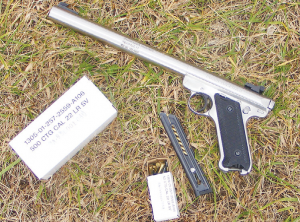
Integrally suppressed units often look like heavy barrels. This Ruger Mk II has a 6-inch barrel and suppressor, and was built by the late Dale Summers. With subsonic ammunition, it is as quiet as a gun gets.
Of course, for this application, a lightweight suppressor is an advantage because adding a lot of weight to the muzzle of the gun would slow the gun down considerably. For fast, transitional shooting, size and weight are an important consideration. Remember, the suppressor is on the extreme end of the gun, so the effect on handling is not one of simply adding weight; the weight on the end of the barrel changes the polar moment of the gun, drastically changing handling characteristics. Purpose-built guns might have shorter barrels to compensate for the length and weight.
As in the selection of any other device, there are trade-offs to be made when selecting a suppressor. Rimfire units can be quite small and light, but will not work on centerfire guns. All other considerations being the same, larger units are more efficient but, of course, they are heavier and bulkier. If you choose to use it on different guns, you might want a unit that’s easy to remove and replace. In choosing a suppressor, you should take into consideration the rate of fire.
Suppressors don’t generate heat but they do retain the heat from existing gasses escaping the muzzle and smaller units don’t have the ability to dissipate that heat quickly.
While compact, lightweight units work well for slow fire situations, the excessive heat buildup caused by rapid-fire conditions will shorten the life of the suppressor.
The process of heating and cooling breaks down the metal in a suppressor so units that are exposed to very high rates of fire like full auto weapons should be designed for such use or the life of the suppressor will be seriously shortened. The larger the unit, the easier it is to dissipate the heat generated, so rapid fire models are bulkier.
Earlier generations of suppressors utilized fillers or packing to help reduce sound. Some also were shot as “wet” suppressors, or “wet cans,” using water, oil or grease to help reduce noise. For this purpose, water works best, but it also evaporates out of the suppressor more quickly and with every shot the suppressor is less quiet.
Modern units are efficient enough without needing the inconvenience of packing to be replaced or liquids to spray oils or water into the air in firing. Since the tax stamp is paid on a specific serial number suppressor, upgrading by redesigning internals is more popular than replacement. There are shops who specialize in just that.
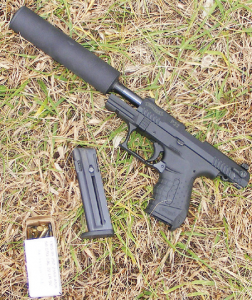
Rimfire units can weigh under three ounces and can fit multiple guns. This Yankee Hill Mite is on a Walther P22 and has little effect on the way the gun feels in your hands.
Since the cost of a suppressor can be as much as the firearm it’s attached to and the tax stamp required is $200 in addition to the cost of the suppressor, it makes sense to have the ability to use the suppressor on more than one gun.
That flexibility should be part of the decision choice when choosing the right suppressor for your needs. A Yankee Hill unit I tested is a 9mm can that uses a serviceable one-piece baffle and a quick twist ½” 28 thread that’s compatible with rimfire versions of M4, M16, and AR15 rifles. It’s designed to be used on 9mm pistols and rifles but it works equally well on .22 rimfire ARs, .22 pistols, and other rimfire rifles giving complete versatility in the ability to be used on any gun fitted with an adapter. If the suppressor is only to be used on a single rifle or pistol, the mounting system can be simpler and there is some additional cost for quick change systems.
For centerfire rifles, suppressor units can be multipurpose as well. My friend, Chris Cerino, of Top Shot Season I and Chris Cerino Training Group, uses a Gemtech .308 can on his Remington 700 and has a quick adapter on his AR platform rifles as well.
“I know there may be some loss of efficiency but the .308 can works so well I really can’t tell it from a dedicated .223 unit. The level of sound suppression is as good though the unit is heavier and larger than a dedicated .223 unit,” Cerino said. “There’s a great bonus in the ability to get double duty out of the .30 caliber unit.” Of course, caliber selection if you want truly quiet operation is tantamount.
In pistol and rimfire calibers, finding subsonic ammunition isn’t that difficult. For centerfire rifle use, it is quite a bit more difficult. The .300 whisper was developed specifically for use in suppressed firearms and is capable of taking deer-sized animals with bullets from 200 to 250 grains at subsonic speeds. The .300 Whisper has the same base as the .223 round and therefore works perfectly in AR platform rifles.
While the process of legally owning a suppressor is more sophisticated than buying a handgun in most states, it is far from insurmountable. As with almost all other facets of shooting, there’s a lot of incorrect information floating around about suppressors, and this piece is written to clear those up.
Currently, in 39 states individual ownership of a suppressor is legal.
Besides the District of Columbia, the states that do not allow suppressors are: California, Delaware, Hawaii, Illinois, Iowa, Massachusetts, Minnesota, New Jersey, New York, Rhode Island, and Vermont. In some states recent laws have made it easier to obtain a suppressor. For instance, in my home state of North Carolina, a December 12 change in the law makes the legal requirements identical to federal law, making the process simpler. Other states have passed similar laws. Your dealer can inform you on the requirements in your state.
The requirements for owning a suppressor are not as complicated as one might think. As an example, in North Carolina, I would select the specific unit I wanted from a local dealer. The dealer would fill out Form Four, the federal application. In my case, I’d go to the County Sheriff and he would have to sign off and provide the fingerprints. I would then take the paperwork back to the dealer who would send it off. Normal turnover is about four to six months.
With the growing interest in suppressors and the simplicity of obtaining them, this is a fast growing part of recreational shooting. Suppressors offer practical applications for law enforcement, as well as recreational, and competitive shooting. My interest is raised and I plan to obtain a suppressor.
Watch these pages for a follow up on the process.
Credit: When I decided to write this, my first thoughts went to an old friend, Jim Weaver, who has been a competitive shooter for over 30 years and owns Top Ends Inc. In addition to his other projects, he’s built and sold suppressors for 12 years. He handles Elite Iron, AAC, AWC, GemTec and Yankee Hill. Much thanks to Jim for his help in this story and allowing me to play with his many suppressed guns. You can contact him by email: jim@taskslowfire.com, or phone at 336-254-8758.
CLEO approval requirement may be discontinued for NFA
Those interested in suppressors or other NFA-controlled arms will be pleased to learn that the requirement to get the local chief of police or sheriff’s approval on the required federal form may be on the way out, according to the Dealer Wire.
The forms have been a problem for many people because some chief law enforcement officers (CLEOs) have simply refused to process the applications required by the Bureau of Alcohol, Tobacco, Firearms and Explosives. At the inception of the National Firearms Act, the idea was to get the person in front of the chief or sheriff—who was expected to know the “problem children” in his or her jurisdiction. That was potentially appropriate years ago before the advent of the National Instant (Background) Check (NICS) System.
The National Firearms Act Trade & Collectors Association (NFATCA) has sought removal of the CLEO requirement for the last six years, according to NFATCA Executive Director and Board Member Jeff Folloder.
“There wasn’t a lot of high profile aspects of the effort,” he said in a phone interview. “It was a lot of drudgery and detail work trying to get the ATF to go along with removing that requirement.” They eventually did and ran the recommendation up to US Department of Justice. The proposal was returned to NFA Branch for some clarifications. These were completed and the recommendation was sent back up.
Clearing the CLEO requirement off of Forms 1 and 4 has been approved by the DOJ. The revised Forms are being laid out and sent to Office of Management and Budget. They’ll examine the proposed regulations and forms change and open the proceeding up for public comments. When that process is completed, they’ll approve the printing run and disseminate the forms.
Unless something derails the process, the road to federal registration of NFA arms may be smoothed by the NICS process.



